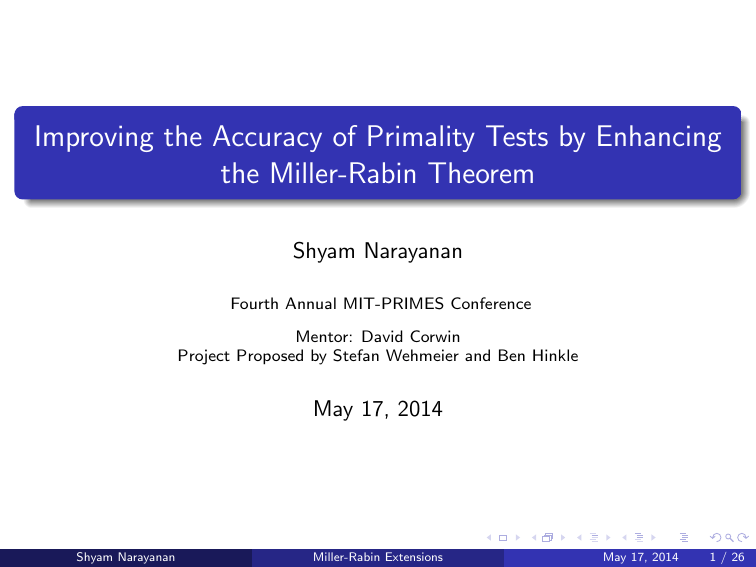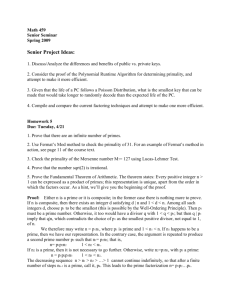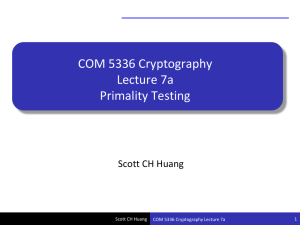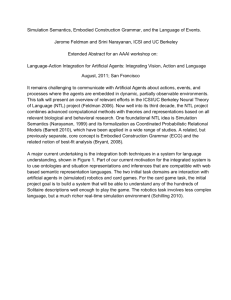Improving the Accuracy of Primality Tests by Enhancing the Miller-Rabin Theorem
advertisement

Improving the Accuracy of Primality Tests by Enhancing the Miller-Rabin Theorem Shyam Narayanan Fourth Annual MIT-PRIMES Conference Mentor: David Corwin Project Proposed by Stefan Wehmeier and Ben Hinkle May 17, 2014 Shyam Narayanan Miller-Rabin Extensions May 17, 2014 1 / 26 Overview 1 Introduction 2 Purpose 3 Results 4 Problems and Conjectures 5 Summary Shyam Narayanan Miller-Rabin Extensions May 17, 2014 2 / 26 Outline 1 Introduction 2 Purpose 3 Results 4 Problems and Conjectures 5 Summary Shyam Narayanan Miller-Rabin Extensions May 17, 2014 3 / 26 Primality Test Definition A primality test is an algorithm for determining whether an input number is prime. Trial division: divide n by every number from 2 until n − 1 Deterministic Primality Tests: Always accurate, but slower Probabilistic Primality Tests: faster, but are not accurate. Shyam Narayanan Miller-Rabin Extensions May 17, 2014 4 / 26 Fermat Primality Test Probabilistic primality test to determine whether a number is a probable prime. Fermat’s Little Theorem states that x p−1 ≡ 1 (mod p) for all x relatively prime to a prime p. Implementation: For arbitrary integer n, pick random x, where 1 ≤ x < n. If x n−1 6≡ 1 (mod n), then n is composite. If not, then n is probably prime. Shyam Narayanan Miller-Rabin Extensions May 17, 2014 5 / 26 False Witnesses Definition For integers n and x with 1 ≤ x < n, we say x is a false witness to n if n is composite but the Fermat primality test states that n is probably prime in base x. Shyam Narayanan Miller-Rabin Extensions May 17, 2014 6 / 26 Weakness of Fermat Primality Test High rate of false witnesses Carmichael numbers - for any Carmichael number n, every x relatively prime to n is a false witness Infinitely many Carmichael numbers Shyam Narayanan Miller-Rabin Extensions May 17, 2014 7 / 26 The Miller-Rabin Primality Test Stronger version of the Fermat Primality Test. Implementation: Write an odd integer n as n = 1 + 2e · d, where d is odd. i Then for an integer x(1 ≤ x < n), if x d ≡ 1 (mod n), or x d·2 ≡ −1 for some 0 ≤ i ≤ e − 1, then n is probably prime. Else, the integer n is composite. Running time: O(log2 (n) · log(log(n)) · log(log(log(n)))). More accurate than the Fermat primality test but still not always accurate. Shyam Narayanan Miller-Rabin Extensions May 17, 2014 8 / 26 Definitions Strong Psuedoprime and Nonwitness If n is composite and 1 ≤ x < n, we say n is a strong pseudoprime to the base x if the Miller-Rabin primality test outputs n as probably prime in base x. In this case, we say x is a nonwitness to n. Else, we say x is a witness to n. Nonwitness for Miller-Rabin, False witness for Fermat NW(n) We define NW (n) as the number of nonwitnesses of n. Shyam Narayanan Miller-Rabin Extensions May 17, 2014 9 / 26 Sample Test Suppose n = 91 and x = 4. 91 = 1 + 21 · 45. 445 ≡ 64 (mod 91), and 490 ≡ 1 (mod 91). 4 is a false witness for the Fermat Primality Test. But it is a witness for the Miller Rabin test. Shyam Narayanan Miller-Rabin Extensions May 17, 2014 10 / 26 Outline 1 Introduction 2 Purpose 3 Results 4 Problems and Conjectures 5 Summary Shyam Narayanan Miller-Rabin Extensions May 17, 2014 11 / 26 Purpose of this Research For very large integers, deterministic primality tests are slow and probabilistic primality tests tend to be very inaccurate. For example, the probabilistic Miller-Rabin Primality Test often fails to detect composite integers. The main goal of this project is to create an improved primality test based on Miller-Rabin. The idea: eliminate certain special forms of composite numbers that have many nonwitnesses. This research has important applications, as it reduces the number of Miller-Rabin iterations needed. Shyam Narayanan Miller-Rabin Extensions May 17, 2014 12 / 26 Outline 1 Introduction 2 Purpose 3 Results 4 Problems and Conjectures 5 Summary Shyam Narayanan Miller-Rabin Extensions May 17, 2014 13 / 26 Accuracy of Miller-Rabin Test The Miller-Rabin Primality Test has significantly fewer nonwitnesses than the Fermat Primality Test. Michael O. Rabin proved the following theorem in 1980: Theorem 1 (Miller-Rabin Theorem) NW (n) ϕ(n) = M(n) ≤ 14 . Suppose Then Shyam Narayanan M(n). Miller-Rabin Extensions May 17, 2014 14 / 26 Formula for NW(n) Explicit formula for the number of nonwitnesses of n given n’s prime factorization. This formula was previously stated by Charles R. Greathouse IV, but an original proof is presented in my research paper. Theorem 2 Consider an odd composite integer n with m distinct prime factors. Suppose that n − 1 = 2e · d and d is odd. Q qi Also suppose that n = m i=1 pi , and each pi can be expressed as 2ei · di + 1, where each di is odd. The number of nonwitnesses NW (n) equals Q min(e )·m ( 2 2mi−1 −1 + 1) · m i=1 gcd(d, di ). Shyam Narayanan Miller-Rabin Extensions May 17, 2014 15 / 26 Extension of the Miller-Rabin Theorem Theorem 3 (Main Theorem) M(n) = 1 2 1 4 if and only if n is one of two forms: n = (2x + 1)(4x + 1), where x is odd and 2x + 1 and 4x + 1 are prime n is a Carmichael Number of the form pqr , where p, q, r are distinct primes ≡ 3 (mod 4). 1 6 < M(n) < 14 if and only if n = (2x + 1)(4x + 1), where x is even and 2x + 1, 4x + 1 are prime. M(n) = 16 if and only if n is of the form (2x + 1)(6x + 1), where x is odd and 2x + 1, 6x + 1 are prime. Else, M(n) ≤ Shyam Narayanan 5 32 . Miller-Rabin Extensions May 17, 2014 16 / 26 New Test 1 Determine if n is of the form (2x + 1)(4x + 1) for some integer x. 2 Determine if n is of the form (2x + 1)(6x + 1) for some integer x. 3 Determine if n is a Carmichael number of the form pqr , where p, q, r ≡ 3 (mod 4). 4 Perform the Miller-Rabin Test for a certain base. Shyam Narayanan Miller-Rabin Extensions May 17, 2014 17 / 26 Experimental Results about Nonwitnesses Define na as the smallest composite n so that the first a prime numbers are all nonwitnesses to n. All of n1 , ..., n11 are one of two forms: 1 2 (x + 1)(kx + 1), where 2 ≤ k ≤ 5 Carmichael numbers pqr , where p, q, r ≡ 3 (mod 4) Of the 3773 strong pseudoprimes less than 4 · 1012 , 3187 of them were of the form (x + 1)(kx + 1), where k is an integer and x + 1 and kx + 1 are primes. Shyam Narayanan Miller-Rabin Extensions May 17, 2014 18 / 26 Outline 1 Introduction 2 Purpose 3 Results 4 Problems and Conjectures 5 Summary Shyam Narayanan Miller-Rabin Extensions May 17, 2014 19 / 26 Checking for Carmichael numbers There is currently no fast way to check if a number is a Carmichael number. However, if n is a Carmichael number of the form pqr , where p, q, r are primes ≡ 3 (mod 4), the following is true: Lemma Regarding Nonwitnesses A positive integer x is a nonwitness to n if and only if ( px ) = ( qx ) = ( xr ) Shyam Narayanan Miller-Rabin Extensions May 17, 2014 20 / 26 Choosing bases Alford, Granville, and Pomerance proved the following Theorem: Theorem 4 For large enough integers A, and for any set S of log(A)1/(3·log log log A) integers, there are at least A1/(35·log log log(A)) Carmichael numbers n ≤ A such that i is a nonwitness to n for all i ∈ S. Unfortunately, this implies that for any set S of integers, there are infinitely many n for which every element of S is a nonwitness. However, certain bases can be chosen to minimize error. Shyam Narayanan Miller-Rabin Extensions May 17, 2014 21 / 26 Open Question If the Generalized Riemann Hypothesis is true, then for all composite odd n, there exists an integer i < 2 · log 2 (n) such that i is a witness. For numbers not of the 3 forms given at the outline of the new test, does this bound shrink? Shyam Narayanan Miller-Rabin Extensions May 17, 2014 22 / 26 Outline 1 Introduction 2 Purpose 3 Results 4 Problems and Conjectures 5 Summary Shyam Narayanan Miller-Rabin Extensions May 17, 2014 23 / 26 Summary and Next Steps In this research, we presented a proof for the number of nonwitnesses for n. Also, the number of nonwitnesses for a composite odd integer n has 5 been reduced to 32 · ϕ(n), except for a few specific forms of n. However, our new primality test requires a method to eliminate effectively Carmichael numbers of the form pqr , where p, q, r are primes ≡ 3 (mod 4). This project is expected to be implemented in MATLAB. Shyam Narayanan Miller-Rabin Extensions May 17, 2014 24 / 26 Acknowledgements I would like to thank my mentor, David Corwin, for the help he has provided me this year, from MATLAB implementations to checking my theorems and progress. I would also like to thank Dr. Tanya Khovanova, the lead mentor, for general guidance. I would like to thank Stefan Wehmeier and Ben Hinkle from MathWorks, who proposed this project and helped me with MATLAB. Finally, I would like to thank the PRIMES-USA program for making this research possible and my parents for all the support they have provided me over the years. Shyam Narayanan Miller-Rabin Extensions May 17, 2014 25 / 26 References Rabin, Michael O. (1980), ”Probabilistic algorithm for testing primality”, Journal of Number Theory 12 (1): 128138 https://oeis.org/A141768 Carl Pomerance, John L. Selfridge, Samuel S. Wagstaff, Jr. (July 1980). ”The pseudoprimes to 25 · 109 ”. Mathematics of Computation 35 (151): 10031026. W.R. Alford, A. Granville and C. Pomerance. ”On the Difficulty of Finding Reliable Witnesses”. Algorithmic Number Theory, Lecture Notes in Comput. Sci. 877, Springer, Berlin, 1994, 1-16. E. Bach, Analytic Methods in the Analysis and Design of Number-Theoretic Algorithms, MIT Press, Cambridge, Mass., 1985. Shyam Narayanan Miller-Rabin Extensions May 17, 2014 26 / 26







